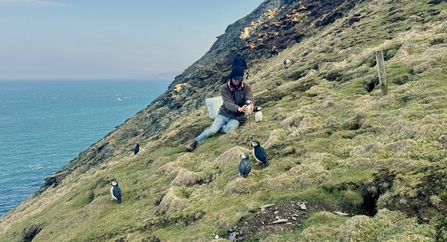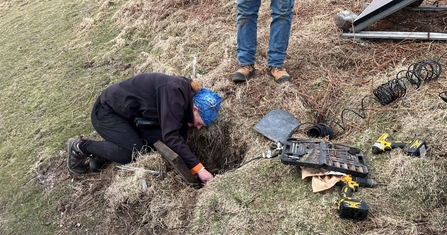
Left to right: Dominic Arkell (Assistant Estate Warden), Kate Fox (Estate Warden), Ed Betteridge (Assistant Ornithological Warden), Eleanor Grover (Ornithological Warden) © Lara Howe

Left to right: Dominic Arkell (Assistant Estate Warden), Kate Fox (Estate Warden), Ed Betteridge (Assistant Ornithological Warden), Eleanor Grover (Ornithological Warden) © Lara Howe
The season started well with a Woodcock flushed from the front garden on arrival. A Red Kite, only the 15th for the Calf, circled the Observatory on the 8th, with a Goshawk over Gibdale on the 24th; only the 13th Island record. The 8th saw both the joint-earliest Calf record of Wheatear and the earliest record of Sand Martin by four days. A record-breaking 22 Whooper Swans went high east on the 16th, calling as they headed back to breeding grounds further north, with GPS tagging data revealing another Whooper Swan flew over Cow on the 26th. The only Black Redstart of the month was a brief male on the 20th, with the third spring Lapland Bunting north on the 30th. The first Swallows were logged on the 28th, with two House Martins on the 30th. Other notable sightings included three Twite, two Red-throated Divers, two Whimbrels, and a ringtail Hen Harrier. The month ended with the arrival of Willow Warbler, with 22 trapped on the 31st.

The record breaking Whooper Swan flock © Ed Betteridge
Bird ringing this month saw 513 birds trapped of 35 species, 383 of these being new. This included the first Water Rail since 2019, the Calf’s fifth Teal to be ringed, and a new annual total of Snipe with 11 caught. A Great Tit ringed on the Calf in 2017 made a reappearance after not being caught in between with another from the Isle of Man. Other scarcities caught were a Collared Dove, a House Sparrow, seven Purple Sandpipers, a Lesser Black-backed Gull, and two Jack Snipe.
The breeding season also started to get underway with the seabirds returning to the cliffs and the first ‘Shag’s’ laying eggs. Ravens are busy incubating, with ‘Chough’s’ busy collecting nesting materials. Single Puffins passed Culbery on the 29th and 30th, further providing hope that these may one day return to the Calf to breed.
On the Estate side of things, the team had a very busy first month getting the island and the Observatory ready for the 2025 season. On arrival, the damage from the severe winter storms was evident across the Calf, including broken gates, lost roof slates, two large trees down, which narrowly missed the Observatory buildings, window boards blown out of the lighthouses, and sections of the outer-brick wall of the foghorn building collapsed. The worst hit area was Cow Harbour, where the force of the wind and storm surge had blown the store door in, and most of the slate roof had blown off. If that wasn’t enough, when we turned our attention to the slipway, it soon dawned on us that a huge chunk of the upper concreted section had been ripped off by the rough sea and deposited in the channel below!
Mike Haigh, one of the 2024 Estate Wardens, joined us for the first two weeks to show us the ropes, and we were very grateful for his guidance. Much of the first few weeks was spent tidying up and repairing the damage from the winter, as well as getting the inside of the Observatory ready for our incoming volunteers and giving the bedrooms and kitchen floor a coat of paint. We have also been working in the garden, getting the allotment up and running again, and planting some fruit trees in the orchard kindly donated by the Manx Ornithological Society in memory of Anne Kaye.
We have also been keeping up the biosecurity monitoring across the Calf, regularly checking our camera traps for the presence of Longtails. Unfortunately, after no sightings during the winter, an individual was recorded after a spell of calm weather in the first few days of the season, presumed to have swum across. We upped our monitoring efforts, peppering the key hotspots with camera traps to pinpoint the animal’s movements. Thankfully, the animal was caught within a matter of weeks, and there have been no further sightings since. This is great news, as the breeding season is just kicking off, but we will remain vigilant if any more unwelcome rodent visitors appear!
The team also headed to the coast, planting decoy Puffins and setting up the cameras and speakers for Project Puffin in the hope of attracting the species back to the Calf as a breeding bird. We also have our live Manx Shearwater cameras set up, thanks to support from Ramsey Crookall and 4G data connectivity provided by Manx Telecom, including two ‘burrow cams’ and a camera outside so you can watch their late-night antics!

Puffin planting! © Kate Fox

Setting up the live Manxie Cameras © Kate Fox